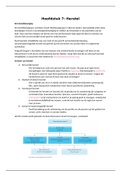Samenvatting
Summary, cases and exam 2020 Strategic management
- Vak
- Instelling
- Boek
This is a summary of strategic management given by prof Elvira Haezendonck thought at the VUB. The summary is based on the slides and on the book Economics of strategy, Besanko et al. Solutions of the cases and the exam questions of the year 2020 are also given. Good luck with studying !
[Meer zien]












